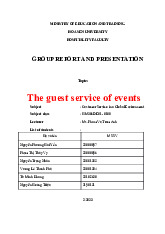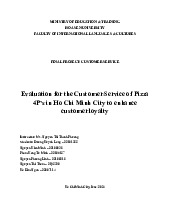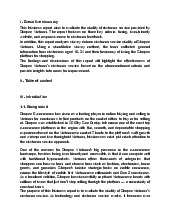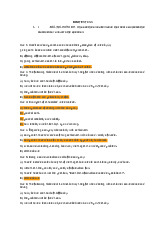



Preview text:
The impact of new technologies on customer satisfaction and
business to business customer relationships: Evidence from the soft drinks industry
https://doi.org/10.1016/j.jretconser.2010.03.008Get rights and content Abstract
Sales technology has been touted as a primary tool for enhancing customer relationship
management (CRM) and thus improving overall customer satisfaction. The marketing, IT, and
practitioner literatures make numerous references to the impact of CRM on business orientation
and performance. However, according to Richard et al. (2007), not many studies have
investigated customer relationship technology adopted by a firm and the impact on relationship
development. The aim of this paper is to examine the relative impact of new technologies on
improving customer relations and overall customer satisfaction within the sales industry. New
technologies have revolutionised the workplace and have become an integral part of
organisations throughout the world (
). Driving this revolution are Forster, 2000 two powerful new
forces, cyberspace and computing power. This article defines three key terms which include
CRM, customer satisfaction and new technologies and evaluates the impact of these emerging
technological developments on relationships and customer satisfaction in a sales force/customer
context. Primary research was conducted using two focus groups consisting of nine participants
from Britvic. The analysis reveals that technology is both beneficial and essential within the
sales force industry for both the sales representative and their customers and provides an insight
into the impact of technology on the sales force/customer relationship. The paper concludes with
reference to new technologies and the future. Introduction
Contemporary literature in the field of marketing (Bagozzi et al., 1999, Gronroos, 2001, Vargo
and Lusch, 2004) highlights the importance of emotions in marketing exchanges and
relationships and how positive emotions can lead to improved consumer satisfaction and loyalty.
According to Ranchhod and Gurau (2004) in the twenty-first century, real progress will be made
by customer centric organisations that can truly understand how and why consumers or
customers behave in the ways that they do. Understanding how to create repeat purchases is
essential in the current competitive climate. Committed customers are profitable to an
organisation for the long term as the customer lifetime value is extended through the creation of
commitment. Commitment forms when a customer's expectation is satisfied and the customer
receives a good experience from his/her relationship with the organisation (Park and Kim, 2003).
In order to fully appreciate how to create satisfaction and thus commitment or loyalty (Gronroos,
2001), companies must first adopt a company strategy that will facilitate the process of being
customer orientated which focuses on relationships as a means to competitive advantage. This
paper has three key objectives. The first is to evaluate the relative significance of creating
satisfaction in today's market place and the importance of customer orientation and CRM for
improving relationships and business performance, with a specific emphasis on the sales
industry. Second to this, is to define technology and examine new emerging technologies and
their contribution in supporting and improving the overall efficiency and effectiveness of the
sales function. The final objective is to provide primary data on the extent to which new
technologies enhance and build relationships for a leading soft drinks manufacturer, by
conducting two focus groups with the sales team. Before evaluating CRM technology and its
impact on building relationships and creating customer satisfaction, it is important to understand
how the successful implementation of CRM technology relies on an understanding of other
aspects to business which contribute towards providing a seamless customer experience. The
first aspect involves a closer examination of customer satisfaction and the business pre-requisites for achieving this. Section snippets
Customer satisfaction, relationships and business performance
Customer satisfaction is recognised as one of the most important elements within any business
management strategy today. In an economically challenging environment where survival is
increasingly difficult across a whole range of businesses, understanding customers and providing
exceptional value and satisfaction, even to the point of exceeding expectations, is crucial. For the
purpose of this paper, customer satisfaction is assumed to be “… a summary cognitive and affective reaction to a
Customer relationship management defined
According to Chen and Popovich (2003) customer relationship management (CRM) is a
combination of people, processes and technology that seeks to understand a company's
customers. Messner (2005) defines the term as “a strategic and action-orientated view on the
relationship between the customer and a company.” Stone and Woodcock (2001) as cited in
Landry et al. (2005) state “CRM is a term for methodologies, technologies and ecommerce
capabilities used by companies to manage customer CRM technology adoption
The term “technology” is broad and has numerous definitions. Howells (2005) states that
technology is “the knowledge of how to organise people and tools to achieve a specific end”.
Schon (1967) citied from Howells (2005) defines technology as “any tool or technique: any
product or process, any physical equipment or method of doing or making by which human
capability is extended”. Schroeder (1989) also citied from Howells (2005) defines technology as
“a set of processes, tools, methods,
New technology and the impact on the sales function
SFA software has developed through a series of different generations over the past decade. Three
generations have been recorded: generation one is personal information and contact
management; generation two is the networked sales force; and generation three is technology-
enabled selling. Compared to the devices available in generation one and two, technology
available in generation three, incorporates a much richer variety of functions considered highly
beneficial for sales people. It is the Methodology
It was felt beneficial to conduct some primary research with employees from the sales industry in
order assess the impact of technology on customer satisfaction. Research was carried out using
two focus groups. Focus group one had five sales representatives and focus group two comprised
four representatives. All respondents were employees of Britvic. Discussions were digitally
recorded and subsequent themes analysed, using a colour coding method (Saunders et al., 2003). The discussion was Results
The findings in general between both focus groups showed more similarities than differences in
opinions. All respondents agreed that the sales function has been improved considerably and has
become much more efficient and effective due to the improved communication and speed of
transactions contributed by technological systems, such as mobile phones with email capability
such as the Blackberry, laptops with appropriate software for dealing with administrative tasks, Tom Tom's, intranet and
The future of technology and the sales function
The successful sales person of the future will be marked by an ability to incorporate and directly
apply a wide range of technology in their interactions with customers. New technologies should
be seen as a means to increasing productivity and as a solution of some of the problems
traditionally faced by sales managers. New technologies have created a mobile sales person and
the ability to work away from a set office environment. In fact the implementation of new technologies will allow Conclusions
Organisations today must focus on delivering the highest value to customers through better
communication, faster delivery and personalised products and services. New technologies have
revolutionized the manual aspects of the filling system and the age of computer automation has
drastically impacted on the customer satisfaction experience. Technological development has
allowed information and resources to be accessed with amazing rapidity and precision. New technologies have enabled both References (28)
R.P. Bagozzi etal.
The role of emotions in marketing
Journal of the Academy of Marketing Science (1999) C. Boshoff etal.
The relationships between service quality, customer satisfaction, and buying intentions in the private hospital industry
South African Journal of Business Management (2004) J.I. Chen etal.
Understanding customer relationship management
Business Process Management Journal (2003)
A. DeCormier etal.
How high-tech dictaphone salespeople use computers: a case study
Industrial and Commercial Training (2003)
R. Deshpande etal.
Corporate culture, customer orientation and innovativeness in Japanese firms: a quadrad analysis Journal of Marketing (1993) C. Fornell
A national customer satisfaction barometer: the Swedish experience Journal of Marketing (1992) N. Forster
The potential impact of third-wave technologies on organizations
Leadership & Organisational Development Journal (2000) C. Gronroos
Service management and marketing, A Customer Relationship Management Approach (2001)
J.L. Heskett etal.
Putting the service profit chain to work Harvard Business Review (1994) J. Howells
The Management of Innovation & Technology (2005)




